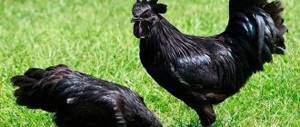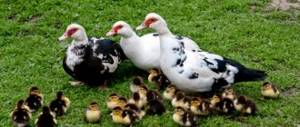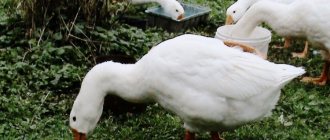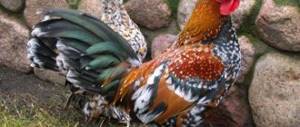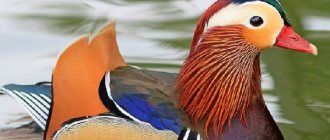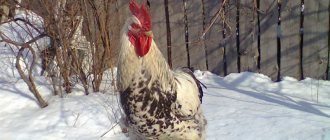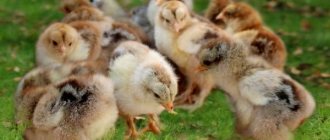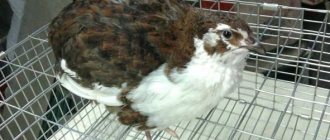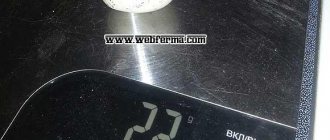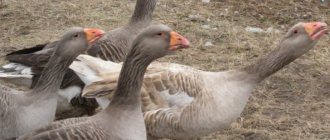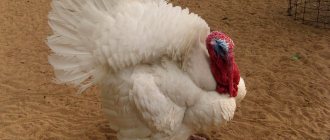General description of the Paduan breed
Chickens are light and graceful. All parts of the body are proportional to each other. The bright plumage is distributed harmoniously.
Ring size: rooster - IV, hen - V. Head of medium size. The structure of the cranial bone is distinguished by a significant protrusion on which a luxurious crest is located. In roosters, the crest looks like a mane, with thinner feathers on the sides and back. The crest of a chicken resembles a ball, it is more compact.
The beard is well developed, it is evenly fixed and looks harmonious with the rest of the plumage. These chickens do not have a comb; this is necessary for optimal placement of the crest.
Earrings are also missing, replaced by a wide beard. The beak is massive, strong, slightly curved. The nasal openings protrude slightly above the general level. The color of the beak depends on the variety, often having a bluish tint.
The eyes are round, large, and have a lively sparkle. The color can be dark orange or red, depending on the variety of Paduan. The face has a deep red color, the lower part is covered with a lush beard. The neck is strong, arched, slightly curved, and completely covered with feathers. The shoulders are strong, wide, semicircular.
The Tetra chicken breed is the result of breeding work by scientists. Read about their properties on our website. For all the information you need to know about Red Whitetails, click here.
The body is slightly stocky, gradually tapering from the shoulders to the tail. The body position is almost horizontal, the torso is slightly raised. The wings are of medium length, held horizontally, pressed close to the body. The tail is long, wide, radiating from the center in separate braids. The tail forms an angle to the back line of 40/45° in roosters and 30/35° in hens.
The chest is quite full, well rounded, slightly protruding forward. The legs are moderately long, without feathers, and have four toes. The skin color of the legs resembles blue slate. The plumage is well developed, fits tightly to the body, the shape of the feathers is round. The skin is light, almost white.
Features of chickens
The Paduan chicken perfectly performs a decorative role.
Its unusual color, length and arrangement of feathers fascinate many lovers of unusual species of birds and ordinary observers. The Paduan bird can become a pet.
Paduans have a calm, balanced character . By nature they are very friendly, trusting and non-conflicting. If they live in a house where they receive a lot of attention, they begin to show individual character traits.
They are often very understanding and reasonable. If you treat the Paduan with care, the bird can easily learn to eat from your hand, travel around the room or yard, climbing onto the owner’s shoulder or hand.
Sometimes they are jealous and may show traits of selfishness, but these birds rarely display negative emotions. Paduans behave like ordinary pets; their character and relationship with the owner directly depend on the attitude towards them.
In terms of productivity, Paduan meat and egg chicken. Paduan lays about 120 eggs per year. The weight of one egg is no less than 50 g, the color of the eggs is white. The weight of a chicken ranges from 1.5 kg to 2.5 kg, so raising them for meat is not a profitable trade.
Chickens are practically omnivorous, but there is no need to take advantage of this quality . As soon as chickens eat something unsuitable, too fatty, or a product containing an infection, the bird immediately gets sick.
Only a veterinarian can diagnose the disease and prescribe the necessary medications. You need to carefully monitor the diet of these chickens.
Breeding
When breeding Paduans, it is important to remember that the females of these birds are poor brood hens, so it is better to place fertilized eggs in an incubator or give them to experienced brood hens of other breeds for incubation.
It is not recommended to keep hatched chicks together with chickens of other breeds, since for small Paduans, foreign chicks can damage the upper outgrowths of the skull during fights.
It is better to buy the first batch of Paduans from experienced breeders who have the appropriate certificates from veterinary clinics. These breeders can provide advice on the maintenance of a specific subspecies.
Varieties and photos
- White Paduan.
The plumage of these birds looks like a classic white livery of uniform uniform color. The color becomes a shade darker in the tail area. Defects: presence of some black feathers in the mantle. - Black Paduan.
The plumage of these chickens is colored black with a uniform, uniform color; roosters have bright feathers of dark blue shades, especially in the tail area. Defects: presence of rare white feathers throughout the plumage. - Silver Paduan.
White plumage alternates with black feathers. In chickens, alternating coloring is evenly distributed throughout the body; in roosters, it may be unevenly distributed across areas of the body. Defects: spontaneous distribution of white and black feathers. - Golden Paduan.
The plumage is fawn in color, alternating with black feathers. The color may be unevenly distributed over the body, and sometimes separate large clusters of black and fawn appear. Defects: presence of white feathers in the plumage, incorrect border of colors in the plumage. - Paduan Shamoa. The yellowish-brown feathers are edged with white. In chickens, the color can be either uniform or distributed in different areas. Defects: Black feathers occur, irregular borders of white and tan colors are present.
- Dwarf Paduan.
A smaller version of the classic Paduan. Their weight is less than that of ordinary Paduans. Hens weigh up to 0.8 kg, roosters up to 0.9 kg. Average productivity is approximately 100 eggs per year. Defects: low egg production, mainly decorative role.
Ancient Roman chickens
The history of the appearance of the Paduans goes back centuries. They were already known during the Roman Empire. In 1927, in the Pius-Clement Museum, 2 figurines were found that clearly depicted small birds with large feathery crests on their heads. The production of these figurines dates back to the 1st-2nd centuries AD. Most likely, it was a bird of aristocrats, since it was given the honor of being placed on ancient Roman figurines.
Chickens of the Paduan breed in the photo
The specific purpose of the Paduans is as decorative birds, but many peasants in Tsarist Russia in the 18th century boldly used this breed of chicken, like any other meat or egg-producing one. The hometown of the Paduans is considered to be Padua in Italy. Hundreds of merchants came to this city to buy these strange birds, and eventually these chickens began to be named after the city itself - Padua.
The entire Paduan breed is divided into several subspecies:
White Paduan is distinguished by its light plumage, or rather white. Long and thin feathers hang from the animal's head, completely covering its eyes. On the White Paduan's plumage itself there are small color defects, namely black stripes or spots. The animal is very tall on its legs and has a bluish-purple hue to its limbs.
READ ALSO: Delicious potato variety Aurora
White paduan in the photo
Black Paduan - As you might have guessed, these birds have dark colored feathers - black or dark blue. Their crest is not as fluffy as that of the White Paduan, but the plumage is denser and denser. There are also some defects on the mantle - white or cream spots.
Black paduan in the photo
Golden Paduan. This animal got its name for a reason. The color of this chicken has a bright orange hue, which shimmers like gold in the sun. White or purple inclusions are also available in this color. The massive feathers that extend from the Golden Paduan's crest give the animal the appearance of an incredibly thick neck.
Golden paduan in the photo
Paduan Chamois. This bird is very similar to the Golden Paduan, but at the same time, along the entire perimeter of the golden wings, Chamois has a dark border, which gives the bird’s plumage a strict and exotic appearance. These chickens, like the Golden Paduan, have very bright and lush plumage, but the tail of Chamois mostly contains white feathers.
Paduan Chamois in the photo
The Silver Paduan has very rich white and black plumage colors. The bird itself, although very fluffy, all its feathers fit tightly to the body. The black and white plumage has a somewhat glossy surface that reflects sunlight. This characteristic gave the name to the subspecies.
Silver paduan in the photo
And despite the fact that the Paduan breed itself is considered decorative, its subspecies also includes a dwarf type of breed. These are very small birds, the maximum weight of which does not exceed 1 kg. Unlike other representatives of the species, Dwarf Paduans have loose plumage. It seems that it is just a lump of feathers or a small stump overgrown with mosses and mushrooms.
Growing Paduans
It has already been said that sunny Italy is considered the homeland of the Paduans, and this indicates that well-heated rooms or barns are needed to raise these birds. There is one big minus in the genotype of this breed. Their immune system is very sensitive to colds. Under no circumstances should such birds be kept in the cold or released into the rain. Once Paduan gets sick, it is quite difficult to cure him and only in extreme cases is this possible.
Appearance of the Breed
Paduans are very poor chickens as brood hens. It is rare for a hen to hatch eggs before the deadline. Therefore, it is better to lay such eggs in an incubator. After the chicks are born, there are strict instructions to keep the chicks from dying. Remove Paduan chicks from the incubator only after they are dry.
The room in which the young are placed after birth must be as warm and dry as possible; the temperature in such an enclosure or even a box must be above 30 degrees; in the worst case, the birds will die. For the first 2 weeks, young Paduans need to be fed hard-boiled eggs (grated) and sifted feed. This is a very voracious breed of chickens, so young Paduans need to be fed every 2 hours.
Paduan Chamois - video
https://fb.ru/article/412440/kuryi-paduan-opisanie-porodyi-osobennosti-soderjaniya-uhod-i-foto
https://1inkubator.ru/vidy-i-porody/poroda-kur-paduan.html
https://greenologia.ru/eko-zhizn/xozyajstvo/fermerstvo/pticevodstvo/kury/porody/paduan.html
https://xn--e1aelkciia2b7d.xn--p1ai/stati/pticevodstvo/dekorativnye-kury-paduany.html
Maintenance and cultivation
The lifestyle of Paduans can be the same as that of ordinary chickens. Paduans live in special poultry houses or well-insulated sheds.
In the cold season, in the room where birds live, it is advisable to additionally insulate the floor; you can mix hay with peat and cover the floor with a thick layer of it. Chickens of this species should not be allowed to walk in the rain or in frosty weather; they are susceptible to colds.
If chickens walk outdoors, in case of rainy weather, it is necessary to build a shed for them , and in winter weather, avoid drafts in the poultry house.
The room in which Paduans live must be well insulated. Avoid low temperatures and drafts, then the birds will be healthy in the cold season.
Choose selected food for your pets . Dry complete feed is suitable. Carefully review its composition before purchasing.
The composition of granulated feed should include grains, fodder, sunflower cake, and vitamins. Do not buy food with added dyes, growth hormones, or additives to improve taste.
This is not necessary for your birds, harmful additives impair their immunity and the healthfulness of the eggs they produce. Pay attention to the nutritional value of the purchased feed, the optimal protein content is 15%, fat is 5%, it should contain amino acids, calcium, copper, ash, vitamins and minerals.
Oat, corn, wheat, and millet grains are excellent for feeding chickens.
An important feature in the watering of Paduans is their long beard. When they drink water from ordinary drinkers, the feathers of the barbs become wet, which causes their deformation, discomfort for the chickens.
As a result of constant wetting of feathers, dirt sticks to them, along with the microorganisms it contains, which can cause the appearance of parasites.
To avoid this, you need to purchase a nipple drinker. When a bird drinks from such a drinker, only its beak comes into contact with the water, as a result the feathers remain dry, which will protect the chicken from infections.
Always buy clean food from reputable companies. Frozen, sour food and the presence of harmful microorganisms in it can lead to intestinal diseases.
The best prevention is to keep birds clean. If the bird is already sick, you need to start treatment immediately. For example, a severe but common disease, coccidiosis, is cured with sulfadimezine at a dosage of 1 mg of the drug per 1 kg of feed.
In cold weather, warm food will be very useful for your chicken. Peas, lentils, and beans are perfect for this. They should be given to chickens steamed in the evening. In severe frosts, the ideal warm food for your birds is corn, rich in proteins, carbohydrates and fats.
To improve disease resistance, use premixes containing vitamins, amino acids, and necessary chemical elements.
To strengthen the immune system, do not forget to periodically give your chickens greens. The brightness and usefulness of eggs depends on the amount of greenery.
If your chickens are free-range, they should have access to greenery. Give the chickens living in your apartment fresh greens every day or sow them in a pot or other container especially for your pet.
Vegetables and fruits are important for proper nutrition. You can give Paduans peelings that are no longer suitable for cooking, you can pamper them with cabbage, carrots, and apples. All this will well strengthen the immunity of the domestic chicken and improve the quality of the eggs it produces.
Don't let Paduans eat everything they see. It is necessary to limit their access to food products that are unsafe for them. If the chicken is still poisoned, clean the crop. This can be done manually, using a probe if necessary.
Features of reproduction
It is recommended to hatch Paduan chickens in an incubator, because Paduans themselves rarely hatch eggs.
When the chicks hatch, wait until they are completely dry before removing them from the incubator. Pre-prepare a place with a temperature above 29°C for newborn chicks. Small chickens need a warm room; at lower temperatures they will die.
Chicken bedding can be made from fabric or paper. Do not place chickens in a cold place. The floor they walk on and the temperature in the surrounding room should be warm.
For the first ten days, feed the little chicks once every two hours. Use egg mixture (finely chopped hard-boiled egg), special feed for chicks.
Chickens eat cottage cheese, boiled millet, wheat, corn, potatoes, and carrots. All food must be strained through cheesecloth to remove excess moisture. On the third day, the chickens can already eat fresh greens.
Do not allow any dirt to clog the feed. Place the feeder on the edge of the room reserved for small chicks. If dirt appears, remove it from the feed immediately.
Once the chicks are 6-8 days old, carefully begin lowering the temperature every week by 2-3 degrees until the need for heaters passes. Additional heating should be removed when the chickens reach the age of 20 days in summer and 30 days in winter.
When the chicks are a month old, start adding mash to the diet. They consist of a grain mixture with herbs; crushed boiled potatoes are perfect for smaller chickens.
Further care
Shaggy-legged chickens are handled with the utmost care. They are given special conditions:
- warm;
- purity;
- lighting;
- no draft;
- dryness.
The floor of the chicken coop is covered with dry sawdust and straw. Heating and lighting devices are installed and air circulation is ensured.
Day-old chicks are kept light for 24 hours, then the daylight hours are gradually shortened by 1 hour. Upon reaching the age of 2 weeks, the chicks receive 8 hours of light.
Important! Hairless chickens are very thermophilic. They also need to lower their temperature gradually: a couple of degrees every 5-7 days. In clear, warm weather, the young animals are taken outside
Feeding
Feeds containing a lot of calcium and protein are suitable for feeding. During the first ten days, chickens are fed every 2 hours; in subsequent days, up to 45 days of age, the interval is increased to 3 hours. Then they switch to 4 feedings a day.
For up to 5 days, chickens are given a chopped egg with clover, nettles and boiled millet. This is followed by a turning point when the egg is canceled and cottage cheese is introduced. From 2 weeks of age, chickens are fed greens with mixed feed, moisturized with yogurt, broth, and water. Supplements must be added:
- coarse sand;
- chalk;
- yeast;
- boiled ground shells;
- meat and bone meal, fish meal;
- fish fat;
- wood ash.
Balanced feed for chickens
The chicks are fed fermented milk products and clean water, to which they add:
- vitamin formulations;
- antibiotic drugs.
Important! After 50 days, young animals begin to gain weight quickly. During this period they are fed wheat bran, whole grains
Be sure to add beets, carrots, and knotweed.
Analogs
The Paduan chicken has no analogues; its aesthetic features are not transmitted by other species of birds. There are breeds of chickens that vaguely resemble the Paduan, due to the presence of a not so lush, but characteristic crest.
The Russian Crested Chicken is an ancient breed of chicken that was bred in Russia by peasants through selective breeding. Productivity up to 200 eggs per year. On the head there is a rather wide crest, expressed by long feathers, diverging on all sides.
Pavlovsk chicken is a breed of chicken bred in Russia. Annual productivity up to 150 eggs. Attracts with its bright plumage color and high frost resistance. A distinctive feature is also the long crest. Quite narrow at the beginning, consists of a large number of feathers, so it looks like a bun. Usually it rises magnificently above the head, falling on both sides.
